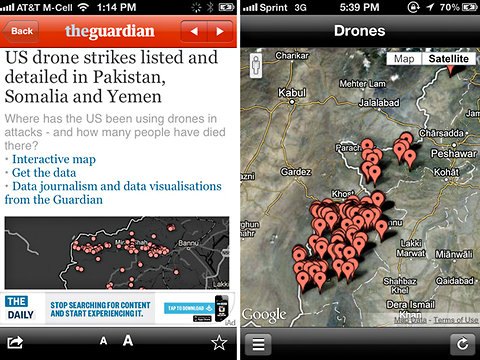This month, the British newspaper The Guardian ran an interactive map of American drone strikes, pinpointing the locations in Pakistan where missiles from the unmanned aerial vehicles struck suspected terrorists. The map, which was based on data from the Bureau of Investigative Journalism in Britain, was available through The Guardian’s app for the iPhone, as well as its Web site.
A graduate student at New York University, Josh Begley, recently took the same data on drone strikes from the same source that The Guardian used and put it into an iPhone app of his own creation that featured an interactive map. While The Guardian’s map was part of a much broader newspaper app featuring all manner of stories, the app by Mr. Begley, called Drone+, was dedicated exclusively to the drone strikes.
On Monday evening, Apple rejected Mr. Begley’s software from its App Store because, the company said, it ran afoul of Apple standards on objectionable content within apps.
How does that compute?
 Information about drone strikes was used both in an article in the Guardian’s app, left, and in an app created by a graduate student at New York University.
Information about drone strikes was used both in an article in the Guardian’s app, left, and in an app created by a graduate student at New York University.
Mr. Begley appears to be the latest developer to fall down the rabbit hole of Apple policies that determine what can and cannot be distributed through the App Store for iPhones and iPads. Most of the time, Apple’s system for approving apps seems to work pretty smoothly, considering the huge volume of apps the company has to deal with. But when it goes awry, it can lead to some real head scratching.
In a phone interview, Mr. Begley said Drone+ had been rejected twice before by Apple’s App Store team for violations of its policies, first because the app was “not useful or entertaining enough,” according to a copy of his e-mail correspondence with Apple supplied by Mr. Begley. The developer added some features, including the ability to push alerts to users of the app whenever a new drone strike was reported. Apple later had another objection related to the placement of Google’s logo on the map within the app.
It wasn’t until this week that Apple notified Mr. Begley that Drone+ had again been rejected, this time for violating provision 16.1 of its App Store guidelines, which bans software that presents “excessively objectionable or crude content.” Drone+ did not contain any graphic images showing the aftermath of drone strikes, Mr. Begley said. It merely presented their locations on a map.
“I wanted to have a more granular sense of what drone strikes really did look like out of genuine curiosity,” Mr. Begley said, describing his motivations for creating the app.
Tom Neumayr, an Apple spokesman, confirmed that Drone+ had been rejected for violating Apple’s policy on objectionable content, but he declined to comment further on the decision. Wired News first reported news of Mr. Begley’s saga on Thursday.
Apple caused a stir in 2010 over its decision to reject an app featuring a satirical political cartoon because of a policy against ridiculing public figures. Apple later accepted the app. The incident created concerns about Apple’s gatekeeper role as more media is distributed through its smartphones and tablet devices.
The case of Drone+ is especially puzzling, though, because the material Apple deemed objectionable from Mr. Begley was nearly identical to the material available through The Guardian’s iPhone app. It’s unclear whether Apple is treating the two parties differently because The Guardian is a well-known media organization and Mr. Begley is not, or whether the problem is that Mr. Begley chose to focus his app only on drone strikes.
Article source: http://bits.blogs.nytimes.com/2012/08/30/apple-rejects-app-tracking-drone-strikes/?partner=rss&emc=rss